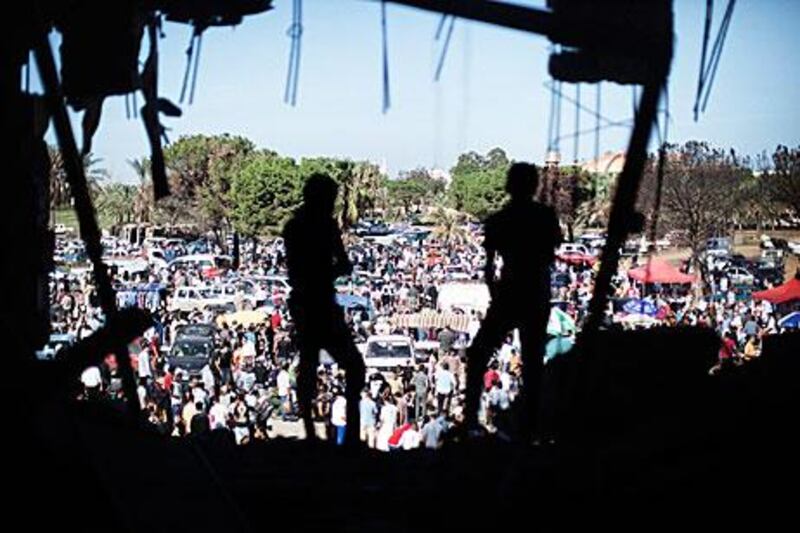TRIPOLI // On a hill in Tripoli, concealed by green metal walls and a stand of trees, is a large, concrete house that is discoloured by fire and graffiti.
"La tana del topo" - "The den of the mouse" - is spray-painted in Italian on a nearby wall. Most likely "rat" was intended for the house belonged to Muammar Qaddafi. Today it is open to the public.
The house stands in Bab Al Aziziya, a military compound that served for decades as the nerve-centre of Qaddafi's regime. Now, every Friday, locals clamber over piles of tumbled concrete to Bab Al Aziziya's parade ground, where vendors come to sell clothing, produce, car parts and other goods. Some also stroll up the hill to explore Qaddafi's house.
One of last Friday's visitors was a mechanic named Abdallah, who had brought along his two young daughters. "Before, it was unthinkable for us to come near this place," he said. "Now, well, just look at it."
Abdallah and his daughters peered from a veranda into rooms gutted by fire. Nearby was an outdoor swimming pool clogged with furniture and charred debris. A network of interlocked tetrahedrons, the house belies the image projected by Qaddafi of tents, robes and desert simplicity.
Qaddafi did own a tent, pitched at Bab Al Aziziya and - when possible - in foreign capitals during his trips abroad. A video that circulated on YouTube after Tripoli's fall shows Qaddafi relaxing in the tent with his family, drinking tea and apparently cooing over grandchildren.
By his own account, Qaddafi was born to a livestock trader near the city of Sirte. In 1969 he led the military coup that overthrew Libya's pro-western king, Idris. Bab Al Aziziya was transformed into a lair from which Qaddafi directed four decades of tyranny.
There were watchtowers, military barracks, concrete administrative buildings and tunnels leading around Tripoli. National Transitional Council (NTC) fighters broke through Bab Al Aziziya's gates in August and laid it to waste. Later, the walls were destroyed and look now as if they were twisted apart by giant hands.
In October, locals began using the parade ground for a Friday market.
This, they say, reclaims the place for its historical use.
At Qaddafi's house, militiamen have covered the walls with graffiti to declare their presence: Souq Al Jumaa brigade, Zintan, Zuwara, and others.
No sign of Qaddafi remains in the ashes.
"Ana gaad hina" - "I will stay here", said one man visiting last Friday, quoting in mockery a televised pledge by Qaddafi in February not to leave Libya. Qaddafi did stay in Libya, but not in Tripoli. He fled the city as rebel fighters closed in and made his way to Sirte.
In Tripoli, painted images of Qaddafi's head on a rat's body - or, sometimes, in a hangman's noose - appeared on the walls. Young men fired celebratory gunfire to the tune of "faynou? shafshoufa waynou?" - "Where is he, frizzle-head, where is he?" - a popular song.
By then, Qaddafi was darting among safe-houses in Sirte as NTC fighters rained fire on the city. At dawn on October 20, he made a break for it. After his convoy was apparently hit by a Nato air strike, militiamen pulled Qaddafi from a culvert where he was hiding.
A video taken by his captors shows him injured, bewildered, yanked about by dozens of hands. Later that day, he was killed by a gunshot to the head.
Beside the culvert, someone spray-painted "the place of the rat, Qaddafi the malevolent". Later, a simpler label appeared beside it: "Qaddafi's hole."





